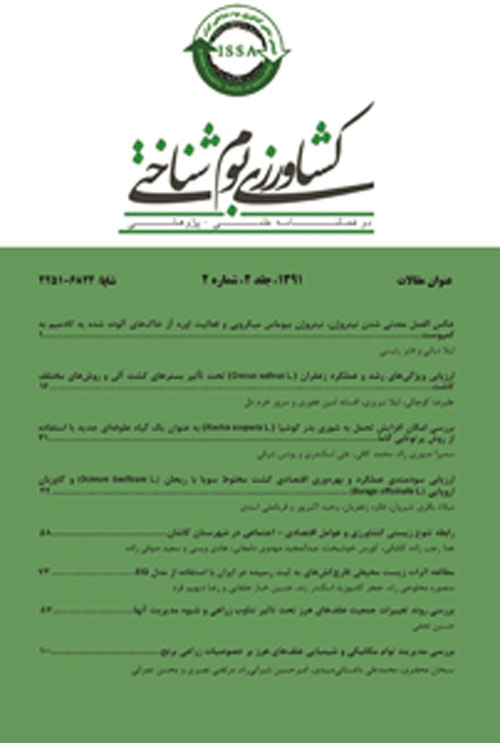Sustainability assessment of wheat and barley agroecosystems by quantitative indices: Case study for Maragheh - Bonab plain, East Azerbaijan province
Author(s):
Abstract:
Introduction
One serious challenge in agriculture during the 21st century is meeting the food demands of the growing population from restricted and decreasing per capita natural resources such as land, water, and minerals with minimum environmental degradation. But, developments in agriculture that heavily rely on chemical inputs such as synthetic fertilizers, pesticides, fossil fuels and other energy-intensive inputs, is having a serious impact on public health and the environment. Therefore, efficient use of resources and inputs is a primary and most vital implications for sustainable development of agriculture. Sustainability indices are quantitative values that can be used to evaluate the efficiency and quality of agroecosystems and are useful tools for making suitable decisions in its management (Mahdavi Damghani et al., 2006). These including energy flow indices, global warming potential (GWP), economic indices, environmental impact quotient (EIQ) of pesticides, efficiency of land, water and fertilizers use and etc.Materials And Methods
In the present study, the sustainability of wheat and barley production systems lies in the Maragheh-Bonab plain in southern East Azerbaijan province in northwestern Iran were evaluated using the aforesaid indices. For this purpose, data was collected from 110 farmers by survey to determine crop production in the region. Secondary data was obtained from previous studies and statistics from organizations such as the Agricultural Ministry of Iran.Results And Discussion
The results showed that the values of input energy, output energy and net energy in wheat production system (34412, 161462 and 127050 Mj ha-1, respectively) were higher than barley production system (29596, 126077 and 96480 Mj ha-1, respectively). Also, it was observed that the values of energy use efficiency and energy productivity of wheat (4.7 and 0.17 kg MJ−1, respectively) were significantly higher than that of barley (2.1 and 0.15 kg MJ−1, respectively). In terms of economic indices, despite of lower total cost of production in barley, the highest values of gross production value, net return, benefit to cost ratio and economic productivity were related to wheat production system. Our results are in agreement with the results of Sahabi et al. (2013). In terms of GWP and EIQ, wheat production had the higher values with compared to barley production. However, eco-efficiency (ratio of economic value to the environmental impact) values based on of GWP and EIQ was significantly higher for wheat (1.26 $ kg -1 CO2eq-1 and 37 $ EIQ-1) than barley (1.03 $ kg-1 CO2eq-1 and 31.4 $ EIQ-1). Also, land, water and fertilizer use indices for wheat were higher than barley. The land use efficiency, land production efficiency, economic land production efficiency, irrigation water productivity, economic irrigation water productivity, nitrogen use efficiency, phosphorous use efficiency and potassium use efficiency were 65.7%, 24.5 kg ha-1 day-1, 6.2 $ ha- 1 day-1, 1.6 kg m-3, 0.43 $ m-3, 56.7 kg kg-1, 136.4 kg kg-1 and 2401 kg kg-1 in wheat production system and 61.6%, 19.2 kg ha-1 day-1, 3.2 $ ha-1 day-1, 1.5 kg m-3, 0.26 $ m-3, 34.8 kg kg-1, 102.3 kg kg-1 and 376 kg kg-1 in barley production system, respectively.Conclusion
It can be concluded that environmental impacts of pesticides and global warming effect per area in barley production system were lower than wheat production system. However, in terms of economic indices, inputs and energy use efficiency, wheat production system was superior to barley production system. Keywords:
Language:
Persian
Published:
Journal of Agroecology, Volume:6 Issue: 2, 2017
Page:
321
magiran.com/p1681005
دانلود و مطالعه متن این مقاله با یکی از روشهای زیر امکان پذیر است:
اشتراک شخصی
با عضویت و پرداخت آنلاین حق اشتراک یکساله به مبلغ 1,390,000ريال میتوانید 70 عنوان مطلب دانلود کنید!
اشتراک سازمانی
به کتابخانه دانشگاه یا محل کار خود پیشنهاد کنید تا اشتراک سازمانی این پایگاه را برای دسترسی نامحدود همه کاربران به متن مطالب تهیه نمایند!
توجه!
- حق عضویت دریافتی صرف حمایت از نشریات عضو و نگهداری، تکمیل و توسعه مگیران میشود.
- پرداخت حق اشتراک و دانلود مقالات اجازه بازنشر آن در سایر رسانههای چاپی و دیجیتال را به کاربر نمیدهد.
دسترسی سراسری کاربران دانشگاه پیام نور!
اعضای هیئت علمی و دانشجویان دانشگاه پیام نور در سراسر کشور، در صورت ثبت نام با ایمیل دانشگاهی، تا پایان فروردین ماه 1403 به مقالات سایت دسترسی خواهند داشت!
In order to view content subscription is required
Personal subscription
Subscribe magiran.com for 70 € euros via PayPal and download 70 articles during a year.
Organization subscription
Please contact us to subscribe your university or library for unlimited access!


